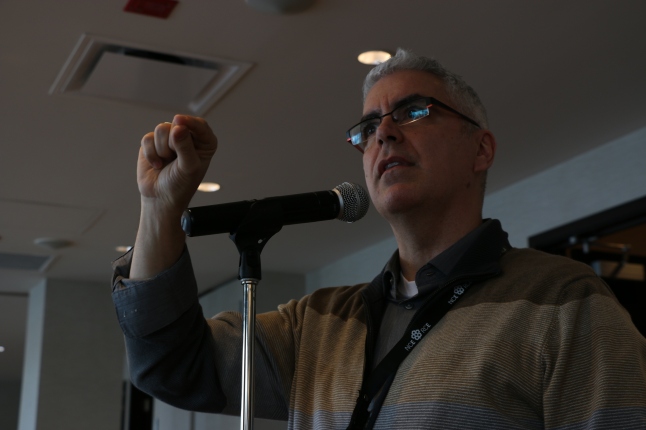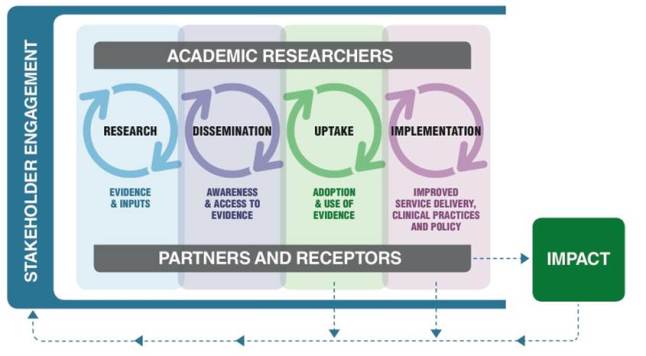by Anneliese Poetz, KT Manager, NeuroDevNet
This past Thursday May 14, 2015 and Friday May 15, 2015 the 2015 Canadian Knowledge Mobilization Forum took place at the Grand Bibliotheque in Montreal, QC. The Canadian Knowledge Mobilization forum is the national conversation on KT/KMb practice and an excellent way not only to build our own skills but to brand NeuroDevNet as a leading KT organization. In fact, it was during this event that David Phipps (NeuroDevNet KT Lead) received the “2015 President’s Award for innovation” in “recognition of his extraordinary contribution to the field and practice of Knowledge Mobilization in Canada and internationally”.

Peter Levesque presents Knowledge Translation award to David Phipps at CKF 15
Photo credit: Pedro Ruiz
The overall theme of the conference was “Creativity as Practice: Mobilizing Diverse Ways of Thinking”. I both learned from other presenters, and shared my own knowledge.
In the workshop “Narratives, video and smartphones as KT tools for youth” (by Sean Muir) I learned that the ‘formula’ for maximizing effectiveness of KT with youth is: grab their attention with a shocking image or story, present your content/message, and then end with something positive. Sean used examples of videos and posters to illustrate this point. In the workshop on “Mobilizing your message through documentary video: research findings as cinematic narrative” (Callista Haggis et al.) the takeaways for creating KT videos were “done is better than perfect”, “show don’t tell” and “think about what you want your target audience to think, feel, do”. In this case, the documentary was both to present research findings in an alternative format, as well as to inspire discussion about the issues presented in the video toward possible infrastructure changes to accommodate the needs of an aging population.
NeuroDevNet’s KT Core Lead, David Phipps, participated in leading 2 sessions. One session was with Purnima Sundar (Ontario Centre of Excellence for Child and Youth Mental Health) and Renee Leduc (NCE Secretariat).
 The audience gained insight into the 3 common reasons why research grant applications fail: 1) lack of meaningful end user engagement, 2) unclear pathway to impact, and 3) poor evaluation of KM (Knowledge Mobilization) and of impact. The NCE Secretariat provided tips on how to prepare a successful research funding application, and held an interactive session asking for the audience’s ideas for what the NCE Secretariat could do to help applicants be more successful. Ideas included: successful applicants’ mentoring of new applicants, creation of how-to videos to accompany written grant application instructions, and provision of examples.
The audience gained insight into the 3 common reasons why research grant applications fail: 1) lack of meaningful end user engagement, 2) unclear pathway to impact, and 3) poor evaluation of KM (Knowledge Mobilization) and of impact. The NCE Secretariat provided tips on how to prepare a successful research funding application, and held an interactive session asking for the audience’s ideas for what the NCE Secretariat could do to help applicants be more successful. Ideas included: successful applicants’ mentoring of new applicants, creation of how-to videos to accompany written grant application instructions, and provision of examples.
David moderated the session on “the paths of sustainability for KMb” in which I was one of the 4 presenters. I presented on the KT Core’s evaluation framework, indicators, and 3 factors relating to sustainability: relevance (how does what we’re doing fit with our priorities), leadership (who is responsible for ensuring outcomes are met), and financial (can cost-effective strategies be used). The presentations were 10 minutes each. When the presentations were over, each presenter took their discussion question to a corner of the room and invited attendees to join their group (depending on which question most interested them) and discuss it further in terms of their own context.
– How are people attempting to influence sustainability across diverse settings with the use of tools?
– How can we sustain KT implementation through strategic planning?
– How can team capacity and culture be shaped over time to best meet the needs of knowledge users?
And my question was:
– What factors should be considered with respect to sustainability?
I had about 12 people in my breakout discussion group. Although I had a discussion question prepared, I received several questions about what NeuroDevNet’s KT Core does in terms of evaluation and also about database design and development. After the breakout discussions we returned to the large group and each presenter did a ‘report back’ about what their group discussed.
“Anneliese provided a great overview of the process she developed to measure the relevance and impact of knowledge translation products. Her experience was very relevant as our organization is currently exploring different methods of evaluating our work. We look forward to learning more about Anneliese’s indicators and database.”
– Sheena Gereghty, Canadian Centre on Substance Abuse
If you are a NeuroDevNet researcher or trainee and would like help with KT videos, advice on event evaluations and/or evaluation of your other KT activities and products, contact the KT Core to find out how we can help.




